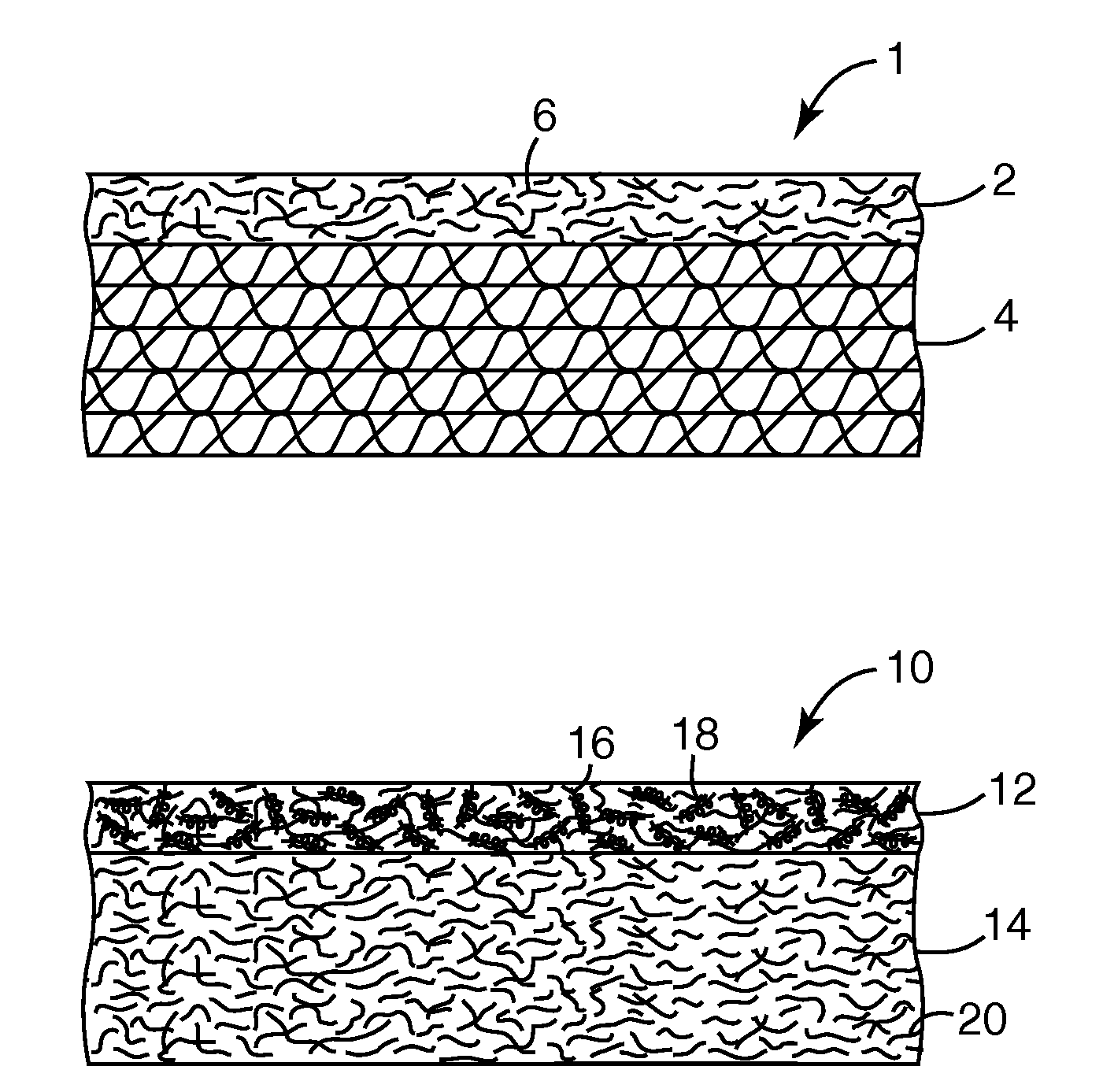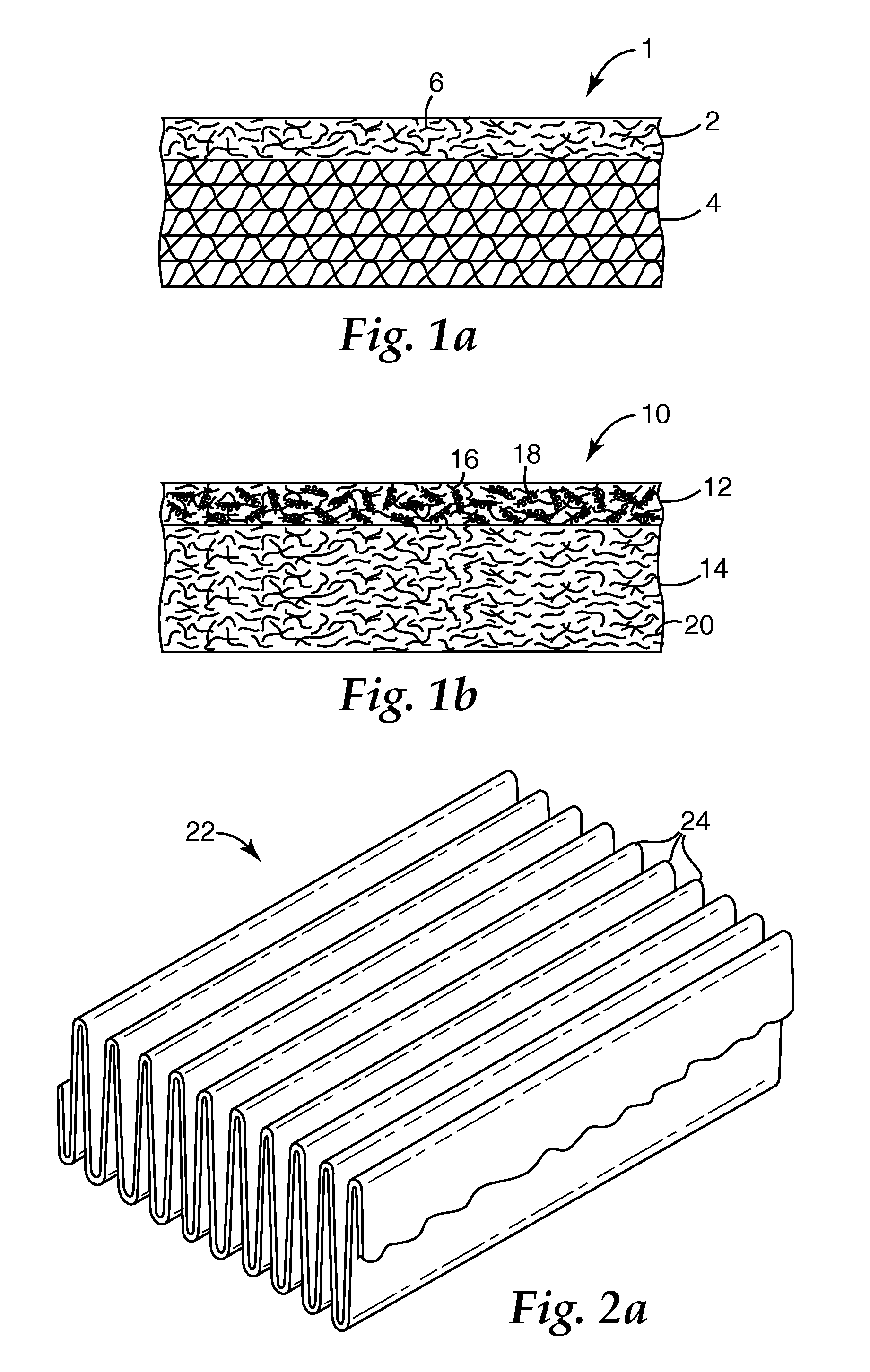Highly charged, charge stable nanofiber web
a nanofiber and high-capacity technology, applied in the direction of filament/thread forming, plasma technique, synthetic resin layered products, etc., can solve the problems of insufficient charge stability, insufficient filtration efficiency, and inability to achieve high-capacity filtration, etc., to achieve a well-correlated initial effect of filtration efficiency
- Summary
- Abstract
- Description
- Claims
- Application Information
AI Technical Summary
Benefits of technology
Problems solved by technology
Method used
Image
Examples
example 1
[0059]Using an apparatus like that shown in U.S. Pat. Nos. 6,607,624 B2 (Berrigan et al. '624) and 6,916,752 B2 (Berrigan et al. '752) and a quenched flow heater like that shown in U.S. patent application Ser. No. 11 / 457,899 filed Jul. 31, 2006, three polypropylene spun-bonded support layer webs were prepared from DYPRO™ 3860 polypropylene having a melt flow rate index of 100 available from Total Petrochemicals. The support web characteristics are shown below in Table 1:
TABLE 1Support Layer CharacteristicsBasis Weight,Thickness,Polymer spinRun No.gsmmmEFD, μmrate, g / hole / min1-11141.12180.91-2850.94120.21-31121.22190.9
[0060]The Run No. 1-1 support layer was corona-charged using a four-beam belt corona charging unit operated using an 3 m / min belt speed and a 29 kV corona voltage, then hydrocharged using a hydrocharging unit operated using a 1.5 m / min belt speed, 0.8 MPa water pressure, and deionized water. Both sides of the web were subjected to water spray and vacuum water removal. T...
example 2
[0078]Using the method of Example 1, a spun-bonded web with a basis weight of 35 gsm, thickness of 0.018 inches, and an EFD of 20 μms was prepared from DYPRO 3860 polypropylene. The resulting support layer web was coated with polypropylene nanofibers at basis weights of 4.6, 7.0 and 27.44 gsm, using a 76.2 cm wide fiber-forming apparatus at Nanofibers, Inc. The nanofibers had an average fiber diameter of about 0.65 μm. Additional characteristics of the resulting multilayer media samples are shown below in Table 7. The pressure drop values were obtained using a 32 liter / minute flow rate:
TABLE 7NanofiberTotal MediaTotal MediaPressureBasis Weight,Basis Weight,Thickness,Drop,Run No.gsmgsmmmmm H2O2-10350.460.152-24.639.600.430.582-37.042.030.470.672-427.462.441.093.37
[0079]These samples could be hydrocharged to provide charged multilayer filtration media containing a nanofiber filtration layer. The nanofibers of Run No. 2-2 were examined using SEM to determine the distribution of fiber s...
example 3
[0080]A propylene melt-blown support layer web having a 55 gsm basis weight, 1 mm thickness, and an EFD of 8.4 μm was prepared on a 50.8 cm wide meltblowing line. Using the method of Example 2, the support web was coated with nanofibers made from DYPRO 3860 polypropylene at basis weights of 1.8, 3.0 and 7.2 gsm. The nanofibers had an average fiber diameter of about 0.77 μm. Additional characteristics of the resulting multilayer media samples are shown below in Table 10. The pressure drop values were obtained using a 32 liter / minute flow rate:
TABLE 10NanofiberTotal MediaTotal MediaPressureBasis Weight,Basis Weight,Thickness,Drop,Run No.gsmgsmmmmm H2O3-10551.021.423-21.856.780.981.863-33.058.001.051.93-47.262.221.092.05
These samples could be hydrocharged to provide charged multilayer filtration media containing a nanofiber filtration layer.
PUM
| Property | Measurement | Unit |
|---|---|---|
| Length | aaaaa | aaaaa |
| Length | aaaaa | aaaaa |
| Length | aaaaa | aaaaa |
Abstract
Description
Claims
Application Information
 Login to View More
Login to View More - R&D
- Intellectual Property
- Life Sciences
- Materials
- Tech Scout
- Unparalleled Data Quality
- Higher Quality Content
- 60% Fewer Hallucinations
Browse by: Latest US Patents, China's latest patents, Technical Efficacy Thesaurus, Application Domain, Technology Topic, Popular Technical Reports.
© 2025 PatSnap. All rights reserved.Legal|Privacy policy|Modern Slavery Act Transparency Statement|Sitemap|About US| Contact US: help@patsnap.com



